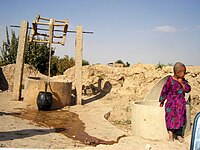
Photo from wikipedia
Scanning electron microscopy (SEM), energy dispersive spectroscopy (EDS), thermogravimetric analysis (TGA), infrared spectroscopy and x-ray diffraction were used to explore the effects of drilling fluid contamination on the mechanical and porosity–permeability properties… Click to show full abstract
Scanning electron microscopy (SEM), energy dispersive spectroscopy (EDS), thermogravimetric analysis (TGA), infrared spectroscopy and x-ray diffraction were used to explore the effects of drilling fluid contamination on the mechanical and porosity–permeability properties of cement stone. The experimental results showed that the mechanical and porosity–permeability properties deteriorated due to contamination by drilling fluid. The deterioration in properties was found to be more serious with an increase in drilling fluid content: for a drilling fluid content of 30%, mechanical properties were reduced by about 50% compared with those of pure cement stone, and porosity and permeability were increased by 7·9% and 0·369 millidarcy (3·6 × 10−12 cm2). SEM, EDS and TGA revealed that chemical incompatibility between drilling fluid additives and cement slurry is the main reason for contamination: the additives contain many functional groups that are not compatible with cement slurry (e.g. carboxylate (–COO−) and a...
Journal Title: Advances in Cement Research
Year Published: 2017
Link to full text (if available)
Share on Social Media: Sign Up to like & get
recommendations!